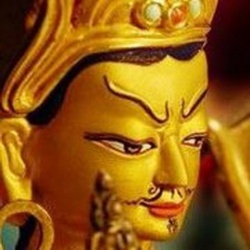Difference between revisions of "Abhidharmakośa-bhāṣya"
(Redirected page to Category:Abhidharmakosha) |
|||
| (3 intermediate revisions by the same user not shown) | |||
| Line 1: | Line 1: | ||
| − | + | [[File:3402 n.jpg|thumb|250px|]] | |
| + | <poem> | ||
| + | [[abhidharmakośa-bhāṣya]]; [[解釋]]: [[Vasubandhu's]] auto-commentary to his [[Abhidharma-kośa]] in which he criticizes the interpretations of the [[Vaibhāṣikas]] and others of the {{Wiki|tenets}} he presented in that work. | ||
| + | |||
| + | His critique is made from the [[Sautrāntika]] standpoint. | ||
| + | |||
| + | This commentary includes an additional [[chapter]] in prose refuting the [[idea]] of the ‘[[person]]’ ([[pudgala]]) as held by some [[Buddhists]]. | ||
| + | |||
| + | The nine chapters in the work deal with what is | ||
| + | |||
| + | [[perceived]] ([[dhātu]]), the | ||
| + | |||
| + | [[sense-faculties]] ([[indriya]]), the | ||
| + | |||
| + | [[world]] ([[loka]]), [[karma]], the | ||
| + | |||
| + | [[proclivities]] ([[anuśaya]]), the | ||
| + | |||
| + | [[Noble Ones]] ([[ārya-pudgala]]), | ||
| + | |||
| + | [[knowledge]] ([[jñāna]]), | ||
| + | |||
| + | [[meditation]] ([[samādhi]]), and | ||
| + | |||
| + | refutation of the {{Wiki|concept}} of a [[self]] ([[anātman]]). | ||
| + | |||
| + | A large number of sub-commentaries on this text have been preserved in [[Tibetan]] translations. | ||
| + | |||
| + | [[Vasubandhu's]] "[[Abhidharmakosa-Bhasya]]" (ca. 380-390), besides its culminating [[achievement]] in streamlining the overall {{Wiki|structure}} of the [[exposition]] of the preceding "[[Abhidharma]]" manuals, is unmatched by any of the preceding manuals in [[respect]] of its comprehensiveness - incorporating all important [[Vaibhasika]] [[doctrines]] since the [[time]] of the [[Abhidharma-mahavibhasa]] - | ||
| + | |||
| + | of its {{Wiki|excellent}} skill in [[definition]] and elucidation, and of its ability to clarify the difficult points involved in [[doctrinal]] disputations. Added to these qualities is its great value as a brilliant critique and [[insightful]] re-evaluation of all the fundamental [[Sarvastivada]] [[doctrines]] developed up to its [[time]]. | ||
| + | |||
| + | Since its [[appearance]], it has been used as a standard textbook for the [[understanding]] of not only the [[Abhidharma]] [[doctrines]] but all the fundamental [[Buddhist]] [[doctrines]] in general. | ||
| + | |||
| + | Translated into {{Wiki|Chinese}} by [[Paramartha]] in 563 A.D. and by [[Hsuan-tsang]] in 651-654 A.D., [[Hsuan-tsang's]] [[disciple]] [[P'u-Kuang]] tells us that in [[India]] the "[[Abhidharmakosa-Bhasya]]" was hailed as the "[[Book of Intelligence]]". In [[China]], [[Japan]] and the Far-east, too, the [[Kosa]] has generally been highly treasured as a textbook of fundamental importance for [[Buddhist studies]]. | ||
| + | |||
| + | [[Vasubandhu's]] brilliant critique of the [[doctrines]] of the [[Vaibhasika]] was answered by the equally brilliant [[Samghabhadra]] - a contemporary staunch defender and expounder of the [[doctrines]] of the [[Vaibhasikas]] - in his masterwork, the "[[Abhidharmanyayanusara]]", now extent only in [[Hsuan-tsang's]] translation (653-654 A.D.). | ||
| + | |||
| + | The [[Sanskrit]] text, considered for a long [[time]] to be irremediably lost, was discovered by [[Rahula Samkrtyayana]] in 1935 in the [[Tibetan]] [[monastery]] of [[Ngor]] and was published by P. Pradhan in 1967 . | ||
| + | </poem> | ||
| + | {{R}} | ||
| + | [http://dictionary.buddhistdoor.com/word/673/abhidharmakosa-bhasya dictionary.buddhistdoor.com/word] | ||
| + | [[Category:Abhidharmakosha]] | ||
Latest revision as of 07:48, 9 February 2015
abhidharmakośa-bhāṣya; 解釋: Vasubandhu's auto-commentary to his Abhidharma-kośa in which he criticizes the interpretations of the Vaibhāṣikas and others of the tenets he presented in that work.
His critique is made from the Sautrāntika standpoint.
This commentary includes an additional chapter in prose refuting the idea of the ‘person’ (pudgala) as held by some Buddhists.
The nine chapters in the work deal with what is
perceived (dhātu), the
sense-faculties (indriya), the
world (loka), karma, the
proclivities (anuśaya), the
Noble Ones (ārya-pudgala),
knowledge (jñāna),
meditation (samādhi), and
refutation of the concept of a self (anātman).
A large number of sub-commentaries on this text have been preserved in Tibetan translations.
Vasubandhu's "Abhidharmakosa-Bhasya" (ca. 380-390), besides its culminating achievement in streamlining the overall structure of the exposition of the preceding "Abhidharma" manuals, is unmatched by any of the preceding manuals in respect of its comprehensiveness - incorporating all important Vaibhasika doctrines since the time of the Abhidharma-mahavibhasa -
of its excellent skill in definition and elucidation, and of its ability to clarify the difficult points involved in doctrinal disputations. Added to these qualities is its great value as a brilliant critique and insightful re-evaluation of all the fundamental Sarvastivada doctrines developed up to its time.
Since its appearance, it has been used as a standard textbook for the understanding of not only the Abhidharma doctrines but all the fundamental Buddhist doctrines in general.
Translated into Chinese by Paramartha in 563 A.D. and by Hsuan-tsang in 651-654 A.D., Hsuan-tsang's disciple P'u-Kuang tells us that in India the "Abhidharmakosa-Bhasya" was hailed as the "Book of Intelligence". In China, Japan and the Far-east, too, the Kosa has generally been highly treasured as a textbook of fundamental importance for Buddhist studies.
Vasubandhu's brilliant critique of the doctrines of the Vaibhasika was answered by the equally brilliant Samghabhadra - a contemporary staunch defender and expounder of the doctrines of the Vaibhasikas - in his masterwork, the "Abhidharmanyayanusara", now extent only in Hsuan-tsang's translation (653-654 A.D.).
The Sanskrit text, considered for a long time to be irremediably lost, was discovered by Rahula Samkrtyayana in 1935 in the Tibetan monastery of Ngor and was published by P. Pradhan in 1967 .
